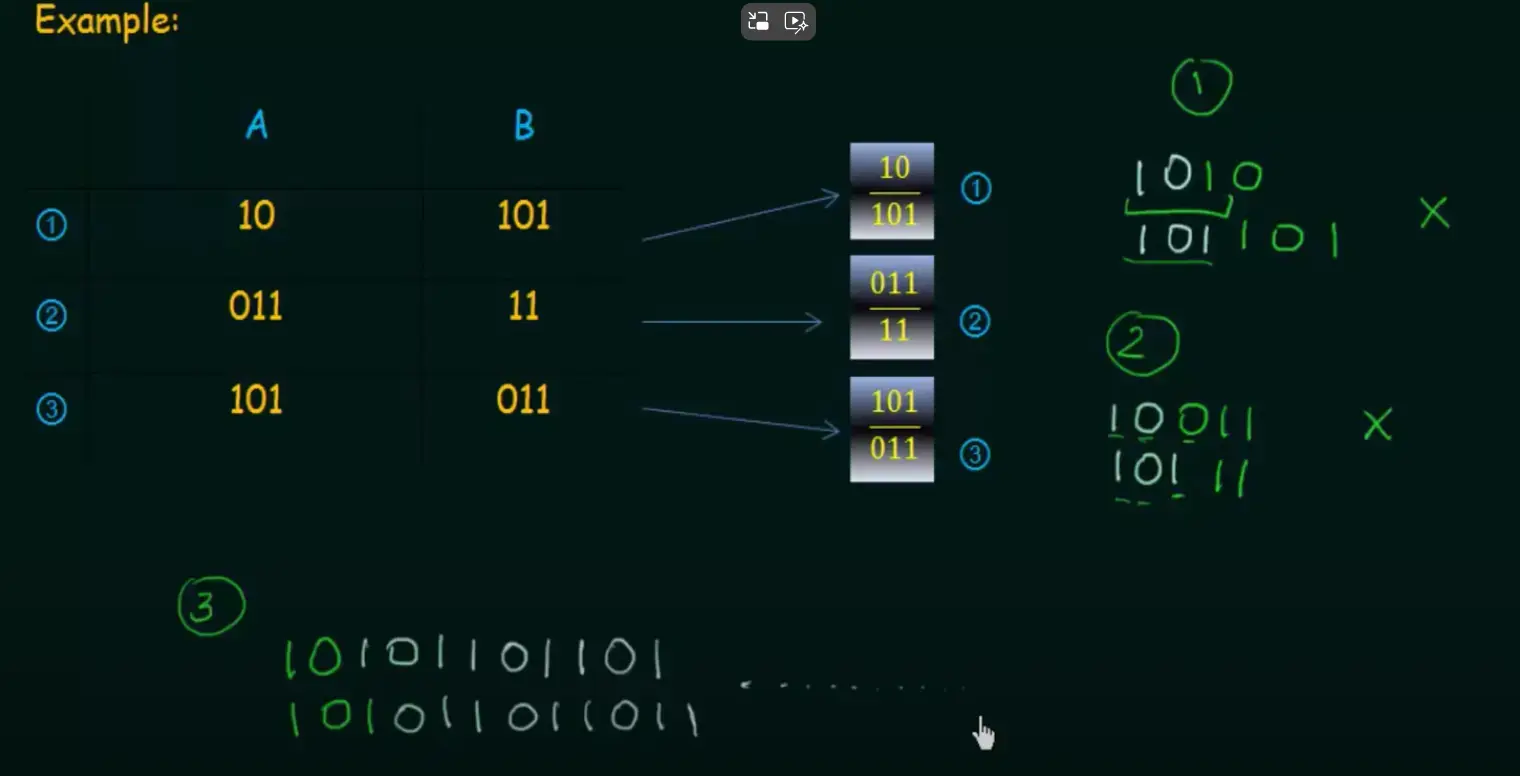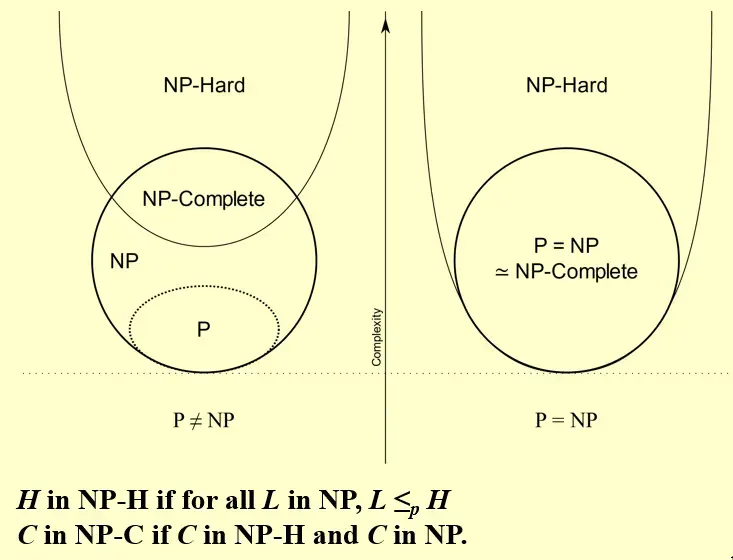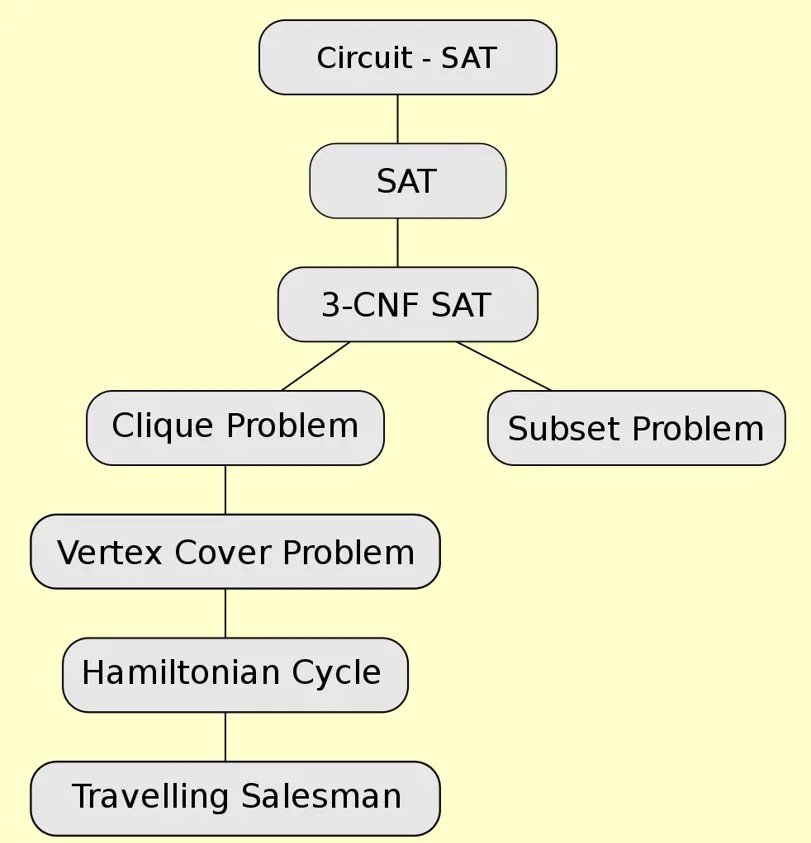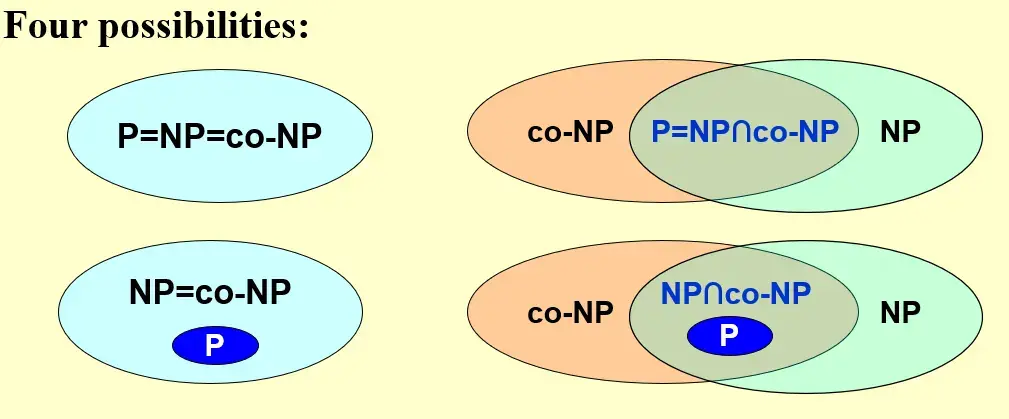10 NP-Completeness
1 Intro#
1.1 Recall: FDS#
- 欧拉回路问题
- 哈密顿回路问题
- 单源无权最短路问题
- 单源无权最长路问题
其中,第一个和第三个比较容易解决,但是第二个和第四个没有已知的多项式时间算法
1.2 Formalization#
Target
让不同问题的复杂度有一个统一的衡量标准
- inputs: binary 将所有类型的输入都统一成比特串,有利于统一时间复杂度表达和比较
- algo: Turing Machine
- outputs: True/False 所有的问题都可以转换成一连串的判定问题
Note
最简单的问题可以是 \(O(N)\) 的,因为至少也需要读入 input 最复杂的问题是不可判定问题 (undecidable problem),无法用渐进符号描述
Undecidable Problem: Halting Problem
- 如果
halts()判定g()会停机,那么g()进入死循环 - 如果
halts()判定g()不会停机,那么g()返回 - 这样就构造了一组矛盾,所以停机问题是不可判定的
2 NP, P, NP-H, NP-C#
| 简称 | 全称 | 翻译 | 含义 |
|---|---|---|---|
| P | Polynomial-time | 多项式时间 | 能够在多项式时间 SOLVE 的问题 |
| NP | Nondeterministic Polynomial-time | 非确定性多项式时间 | 能够在多项式时间内 VERIFY 的问题 |
| NP-C | NP-Complete | NP 完全问题 | 最难的一类 NP 问题 任何 NP 问题都能在多项式时间内归约到 NP-C \(\forall L \in\text{NP}, L\leq_{p}L' \in\text{NP-C}\) |
| NP-H | NP-Hard | NP 困难问题 | 如果一个 NP 问题 \(A\) 能够被归约到问题 \(B\), 那么 \(B\) 比 \(A\) 更难且 \(B\) 是 NP-H 问题 |
| Undecidable | 不可判定问题 | 不存在有限时间算法的问题 不属于任何上述 complexity class |
2.1 Turing Machine#
- Infinite Memory
- 随机读写的 Scanner
-
控制 Scanner 移动和读写行为的 Rules
-
Deterministic Turing Machine: 每一步的操作都由当前的指令唯一确定
- Deterministic Turing Machine: 每一步的操作可以从 finite set 中选择,总是选择能得到解的操作,lucky machine
Attention
Solvable 不一定意味着 decidable
#CS/Algorithm/Complexity-Problem/Post-Correspondence-Problem
一个有趣的 solvable yet undecidable 问题 Post correspondence problem - Wikipedia,通过将问题规约成 Turing Machine 来证明不可判定
和停机问题一样,PCP 是一个 undecidable 问题。
有一些 dominos,top 和 bottom 有不同的字符串,每个 domino 可以使用多次。

找到一种排列方式,使得 top string 和 bottom string 完全相同。
Solvability#
- 找到一个 top bottom 第一个字母一样的 domino
- 以此类推,如果某个部分解 top bottom 不等长,找缺失的字母;如果部分解已经对齐,就得到了答案
但是可以找到这样的例子:
 其中,如果一直尝试配对,将一直放 3 号 domino 而不会停止
其中,如果一直尝试配对,将一直放 3 号 domino 而不会停止
Undecidability#
如果能将一个 undecidable problem 规约到 PCP,那么 PCP 肯定也是 undecidable 的 Undecidability of the Post Correspondence Problem 介绍了如何将 Acceptance Problem of a Turing Machine (命题接受问题,undecidable) 规约到 PCP 来完成证明
2.2 NP: Nondeterministic Polynomial-time#
- 能在多项式时间内验证任何解是否正确的问题
- e.g. #CS/Algorithm/Complexity-Problem/Hamiltonian-Cycle
Attention
不是所有 decicable problem 都是 NP 问题 例如判定一个图是否有 Hamiltonian cycle,这个问题可以在多项式时间内解决;但是要 verify 就必须找出一个 Hamilton cycle,没有多项式时间算法能做到
但是 NP 问题全都是 decidable 的
2.3 Reduction#
\(A\) 类问题的一个实例是 \(\alpha\),如果存在一个程序能够在多项式时间内完成 \(R(\alpha)\to \beta \in\text{Problem }B\),也就是将待解决的 \(\alpha\) 转换成了 \(B\) 类问题的实例 \(\beta\),且对于 \(\beta\) 的解等价于对于 \(\alpha\) 的解,那么就完成了一次从 \(A\) 到 \(B\) 的规约,记作 \(A\leq_{p}B\)。
2.4 NP-H: NP-Hard#
- 如果一个问题具有这样的性质:所有的 NP 问题都能在多项式时间内归约到它,那么这个问题就是一个 NP-H 问题
- NP-H 问题不一定是一个 NP 问题,它可能是无法在多项式时间内得到验证的
- 例如 Halting Problem、优化版本的 TSP 问题(找到一条最短路而不是给出一条长度 \(\leq K\) 的哈密顿环)
2.5 NP-C: NP-Complete#
- \(\text{NP-C}=\text{NP}\cap\text{NP-H}\)
- NPC 问题继承了 NP-H 问题的性质:所有的 NP 问题都能够在多项式时间内归约到它 \(\forall L \in\text{NP}, L\leq_{p}L' \in\text{NP-C}\)
- NPC 问题是 NP 中最难的问题,如果某个 NPC 问题能够在多项式时间内求解(\(\text{P}=\text{NP}\)),则所有 NP 问题都能在多项式时间内求解
2.5.1 Complexity Graph#

2.5.2 Example: Hamiltonian Cycle \(\leq_{p}\) TSP#
- TSP: 对于给定的有权完全图,是否存在一个哈密顿环,使得其总权重 \(\leq K\)
- 只需要将 Hamiltonian Cycle 问题中存在的边赋为 1,不存在的边赋为 2,然后问 \(K=|V|\) 的 TSP 就好
2.5.3 NP-C Problems#
- 第一个被证明是 NP-C 的问题是 Circuit-SAT 问题,对于一个给定的布尔表达式,问是否存在一种赋值方式能够使得表达式为真

3 Formal Language#
3.1 Abstract Problem#
形式语言中,将问题分为 Abstract Problem 和 Concrete Problem,分别是抽象问题和具体问题
- 抽象问题 \(Q\) 是问题实例集合 \(I\) 和问题解集合 \(S\) 的二元对应关系
- 具体问题是对抽象问题的一种编码,将 \(I\) 映射到一个 bitstring 上,\(Q\) 就变成了具体问题
3.1.1 Examples#
- \(\text{SHORTEST-PATH}\)
- \(I=\{<G,u,v>:G=(V,E)\text{ is an undirected graph; }u,v\in V\}\)
- \(S=\{<u, w_{1},w_{2},\dots,w_{k},v>:<u,w_{1}>,\dots,<w_{k},v>\,\in E\}\)
- \(\forall i\in I,\text{SHORTEST-PATH(i)}=s\in S\)
- \(\text{PATH}\) 判定版本
- \(I=\{<G,u,v,k>:G=(V,E)\text{ is an undirected graph; }u,v\in V\text{; }k\in N\}\)
- \(S=\{0,1\}\)
- \(\forall i\in I,\text{PATH(i)}=1\text{ or }0\)
- Encoding
- Map \(I\) into a binary string \(\{0,1\}^*\),则 \(Q\) 是一个具体问题
3.2 Formal-language Theory -for decision problem#
使用形式语言来统一描述
3.2.1 符号表示#
- 字母表 \(\Sigma\) 是一个有限符号集 e.g. \(\{0,1\}\)
- 语言 \(L\) 表示由 \(\Sigma\) 中的字符构成的字符串的集合
- 空字符串为 \(\epsilon\),空语言为 \(\emptyset\)
- 包含所有从 \(\Sigma\) 得到的字符串的语言记为 \(\Sigma^*\)
- \(L\) 的补记为 \(\bar{L}=\Sigma^*-L\)
- 两种语言的拼接 (concatation) 记为 \(L=\{x_{1}x_{2}:x_{1}x_{2}:x_{1}\in L_{1}\land x_{2}\in L_{2}\}\)
- \(L\) 的克莱尼闭包 (Kleene closure) 为 \(L^*=\{\epsilon\}\cup L\cup L^2\cup L^3\cup\dots\)
3.2.2 判定问题#
- 接受和拒绝:如果 \(A(x)=1\) 则算法 \(A\) 接受 (accept) bitstring \(x\in\{0,1\}^*\);如果 \(A(x)=0\),算法 \(A\) 拒绝 (reject) 了 bitstring \(x\)
- 判定:如果 \(L\) 的每一个 bitstring \(x\) 都能够被 \(A\) 接受或拒绝,那么称 \(L\) 能够被算法 \(A\) 判定
P 类问题的描述
\(\text{P}=\{L\subseteq\{0,1\}^*: \text{there exists an algorithm }A\text{ that decides }L\text{ in polynomial time}\}\) 所有存在能在多项式时间内得到判定的算法的语言
3.2.3 验证算法 Verification Algorithm#
\(A(x,y)\),其中 \(x\) 是输入 bitstring,\(y\) 是证书 (certificate),其实也就是另一个 bitstring
- 如果对于 \(x\),存在 \(y\) 使得 \(A(x,y)=1\) 成立,那么 \(A\) 能够验证 \(x\)
- 如果对于所有 \(L\) 中的 \(x\) 都满足上述条件,那么 \(A\) 能够验证 \(L\)
\(L\) 为 NP 问题的充要条件
存在一个多项式时间的双参数验证算法 \(A\) 和一个常数 \(c\),使得
\(L=\{x\in\{0,1\}^*:\text{there exists a certificate }y\text{ with }|y|=O(|x|^c)\text{ such that }A(x,y)=1\}\)
其中的 \(|y|=O(|x|^c)\) 只是为了让解的长度不至于直接影响时间复杂度
这样,就能说算法 \(A\) 能在多项式时间内验证 \(L\) 的解的正确性
3.3 co-NP#
如果已知 \(L\in\text{NP}\),那么 \(\bar{L}\in\text{NP}\) 是否正确?
co-NP definition: 如果 \(\bar{L}\in\text{NP}\),那么 \(L\in\text{co-NP}\)

3.4 Reduction Function#
- 如果存在多项式时间可计算的函数 \(f:\{0,1\}^*\to\{0,1\}^*\) 能够实现 \(\forall x\in\{0,1\}^*, x\in L_{1}\Leftrightarrow f(x)\in L_{2}\),那么 \(L_{1}\leq_{p}L_{2}\)
- 这样的函数 \(f\) 称为规约函数 (Reduction Function)
- 能够在多项式时间内计算出 \(f\) 的算法 \(F\) 称为规约算法 (Reduction Algorithm)
NP-C 的形式语言描述
\(L\in\text{NP}\) 且 \(\forall L'\in\text{NP},L'\leq_{p}L\)
3.5 Example: 证明 Vertex Cover Problem 是 NP-C 问题#
已知 Clique Problem 是 NP-C 问题,证明 Vertex Cover Problem 也是 NP-C 问题。 思路是将 Clique 归约到 Vertex Cover
3.5.1 抽象问题表述#
- \(\text{CLIQUE}=\{<G,K>:G\text{ is a graph with a clique of size }K\}\) #CS/Algorithm/Complexity-Problem/Clique
- \(\text{VERTEX-COVER}=\{<G,K>:G\text{ has a vertex cover of size }K\}\) #CS/Algorithm/Complexity-Problem/Vertex-Cover
3.5.2 证明过程#
- 证明 \(\text{VERTEX-COVER}\in\text{NP}\)
- 对于 certificate \(y\),检查一个图中所有的边是否都被 \(y\) 中的顶点覆盖
- 遍历所有边,每次检查两个顶点中是否有一个在 \(y\) 中,最差的复杂度是 \(O(|E||V|)=O(|V|^3)\)
- 所以 \(\text{VERTEX-COVER}\) 可以在多项式时间内验证,是 NP
- 证明 \(\text{CLIQUE}\leq_{p}\text{VERTEX-COVER}\),也就是一个大小为 \(K\) 的团的充要条件是 \(\bar{G}\) 有一个大小为 \(|V|-K\) 的顶点覆盖
- 充分:取补图,则团内的顶点之间没有边;对于每条边,总有一个顶点是团外的顶点,所以取大小为 \(|V|-K\) 的团外所有顶点,一定构成一个顶点覆盖
- 必要:没有被选择的 \(K\) 个顶点之间一定没有边,于是补图中能够构成大小为 \(K\) 的团
Tip
由于都是判定问题,只需要证明存在性即可,在充分性证明中不需要去讨论 \(|V|-K\) 是否为最小的顶点覆盖,在必要性证明中不需要去讨论 \(K\) 是否为最大的团
4 Concousion of Problems#
| Problem | Type | Complexity Class | Meaning | Reduction | Solvability | Decidability | Notes |
|---|---|---|---|---|---|---|---|
| SAT | Decision | NP-C | Satisfiability of Boolean formulas | Reduced to/from other NP problems | Solvable | Decidable | Basis of NP-completeness proofs |
| Circuit-SAT | Decision | NP-C | Satisfiability of Boolean circuits | Reduced to/from SAT | Solvable | Decidable | First NP-complete problem |
| 3-CNF SAT | Decision | NP-C | SAT for 3-CNF formulas | Reduced to/from SAT | Solvable | Decidable | Special case of SAT |
| Clique | Decision | NP-C | Existence of a k-clique in a graph | Reduced to/from Vertex Cover | Solvable | Decidable | Graph theory problem |
| Subset | Decision | NP-C | Subset sum equals a target | Reduced to/from Knapsack | Solvable | Decidable | Equivalent to special cases of Knapsack |
| Vertex Cover | Decision | NP-C | Covers all edges in a graph | Reduced to/from Clique | Solvable | Decidable | Dual problem to Clique |
| Hamiltonian Cycle | Decision | NP-C | Cycle visits all vertices exactly once | Reduced to/from TSP | Solvable | Decidable | Graph traversal problem |
| TSP | Decision | NP-C | Visits all cities with minimal cost | Reduced to/from Hamiltonian Cycle | Solvable | Decidable | Optimization problem |
| Euler Cycle | Decision | P | Cycle visits every edge exactly once | Reduced to/from degree condition | Solvable | Decidable | Can be solved in polynomial time |
| Single-Source Longest Path | Decision | NP-H | Longest path in a weighted DAG | Reduced to/from other NP problems | Solvable | Decidable | Hard for NP, no known poly-time solution |
| Halting Problem | Decision | Undecidable | Program halts on input or not | Not reducible | Unsolvable | Undecidable | Fundamental undecidable problem |
| Knapsack | Decision | NP-C | Subset with target weight/value | Reduced to/from Subset | Solvable | Decidable | Basis for many cryptographic systems |
| Bin Packing | Optimization | NP-H | Pack items into minimum bins | Reduced to/from other NP problems | Solvable | Decidable | Approximation algorithms available |
| Domination Set | Decision | NP-C | Minimum dominating set in a graph | Reduced to/from Vertex Cover | Solvable | Decidable | Graph theory problem |
| Minimum Spanning Tree | Optimization | P | Minimum weight spanning tree | Reduced to/from Graph Connectivity | Solvable | Decidable | Solvable in polynomial time |
| Maximum Flow | Optimization | P | Max flow in a flow network | Reduced to/from Flow Conservation | Solvable | Decidable | Solvable in polynomial time |
| Bipartite Matching | Optimization | P | Maximum matching in bipartite graph | Reduced to/from Flow Problems | Solvable | Decidable | Solvable using Ford-Fulkerson or similar |
| K-Center | Optimization | NP-H | Partition vertices into k clusters | Reduced to/from Facility Location | Solvable | Decidable | Common in clustering problems |
| Graph Coloring | Decision | NP-C | Assign colors to vertices | Reduced to/from SAT | Solvable | Decidable | Classic graph problem |
| Set Cover | Optimization | NP-C | Cover all elements with subsets | Reduced to/from Vertex Cover | Solvable | Decidable | Basis for many optimization problems |
| Traveling Salesman Problem | Optimization | NP-C | Shortest tour visiting all vertices | Reduced to/from Hamiltonian Cycle | Solvable | Decidable | Different variants include approximation |
| Steiner Tree | Optimization | NP-H | Minimum tree connecting specified nodes | Reduced to/from MST | Solvable | Decidable | Harder version of MST |
| Partition Problem | Decision | NP-C | Split set into equal sum subsets | Reduced to/from Subset Sum | Solvable | Decidable | Special case of Subset Sum |
| Independent Set | Decision | NP-C | Maximum independent vertex set | Reduced to/from Vertex Cover | Solvable | Decidable | Related to Clique and Vertex Cover |
| Minimum Degree Spanning Tree | Decision | NP-C | |||||
| Load Balancing Problem | Optimizatino | NP-H |
5 Discussion#
Question
A knapsack with a capacity \(M\) is to be packed. Given \(N\) items. Each item \(i\) has a weight \(w_i\) and a profit \(p_{i}\). An optimal packing is a feasible one with maximum profit.
This problem is NP-hard.
However, if no items have a size larger than \(N^2\), is it still NP-hard? Explain your answer.
给出一种 dp 算法,遍历所有物品,遍历所有 \(w=1,2,3,\dots,M\),这样时间复杂度为 \(O(NM)\) 或 \(O(N^2W_{max})\)。
如果 \(\forall w, w\leq N^2\),那么 \(W_{max}\leq N^3\),所以变为多项式时间复杂度。
6 Questions#
6.1 Midterm Review#
6.1.1 NP-Completeness#
Given that problem A is NP-complete. If problem B is in NP and can be polynomially reduced to problem A, then problem B is NP-complete. (T/F)
Answer
F 只能推导出 B is in NP,B 不一定能由其他所有 NP 问题在多项式时间内归化得到
6.1.2 Decidable languages#
All the languages can be decided by a non-deterministic machine. (T/F)
Answer
F,存在不可判定问题
6.2 Ex10#
6.2.1 Lanuage Reduction#
Which one of the following statements is FALSE?
- A. A language \(L_1\) is polynomial time transformable to \(L_2\) if there exists a polynomial time function \(f\) such that \(w\in L_1\) if \(f(w)\in L_2\)
- D. If language \(L_{1}\) has a polynomial reduction to language \(L_2\), then the complement of \(L_1\) has a polynomial reduction to the complement of \(L_2\).
Answer
A A 不是 if 是 iff D 将 \(f\) 取反,如果 \(x\not\in L_{1}\),那么 \(f(x)\not\in L_{2}\)?
6.2.2 NP-C Problems?#
Which one of the following statements is FALSE?
- A. SAT, Vertex Cover, Hamiltonian Cycle, Clique, Knapsack, Bin Packing, and Domination Set problems are all NP-completeness problems.
- B. If there is a polynomial time \((1+\frac{1}{2n})\)-approximation algorithm for Vertex Cover with n being the total number of vertices in the graph, then P=NP.
- C. If there is a polynomial time 3/2-approximation algorithm for K-Center, then P=NP.
- D. Given a weighted directed acyclic graph (DAG) \(G\) and a source vertex \(s\) in \(G\), it is NP-hard to find the longest distances from s to all other vertices in \(G\)
Answer
让我们逐一分析每个选项,找出其中的 FALSE 陈述。
选项 A#
陈述:SAT, Vertex Cover, Hamiltonian Cycle, Clique, Knapsack, Bin Packing, and Domination Set 问题都是 NP- 完全问题。
分析:
- SAT(布尔可满足性问题)是第一个被证明的 NP- 完全问题。
- Vertex Cover(顶点覆盖问题)、Hamiltonian Cycle(哈密顿回路问题)、Clique(团问题)、Knapsack(背包问题)、Bin Packing(装箱问题)和 Domination Set(支配集问题)都是经典的 NP- 完全问题。
结论:该陈述是 TRUE。
选项 B#
陈述:如果存在一个多项式时间的 \((1+\frac{1}{2n})\)- 近似算法(其中 \(n\) 是图中顶点的总数)来解决 Vertex Cover 问题,则 P=NP。
分析:
- Vertex Cover 是一个 NP- 完全问题。
- 已知 Vertex Cover 的近似算法的最小近似比为 \(2\)(即 2- 近似算法)。
- 如果存在一个比 \(2\) 更优的近似算法(例如 \((1+\frac{1}{2n})\)- 近似算法),则意味着可以在多项式时间内精确解决 Vertex Cover 问题,从而 P=NP。
结论:该陈述是 TRUE。
选项 C#
陈述:如果存在一个多项式时间的 \(3/2\)- 近似算法来解决 K-Center 问题,则 P=NP。
分析:
- K-Center 是一个 NP- 完全问题。
- 已知 K-Center 的近似算法的最小近似比为 \(2\)(即 2- 近似算法)。
- 如果存在一个比 \(2\) 更优的近似算法(例如 \(3/2\)- 近似算法),则意味着可以在多项式时间内精确解决 K-Center 问题,从而 P=NP。
结论:该陈述是 TRUE。
选项 D#
陈述:给定一个加权有向无环图(DAG)\(G\) 和一个源顶点 \(s\),找到从 \(s\) 到所有其他顶点的最长距离是 NP- 难的。
分析:
- 在 DAG 中,最长路径问题(Longest Path Problem)可以在多项式时间内解决。
- 具体方法:对 DAG 进行拓扑排序,然后使用动态规划计算从 \(s\) 到每个顶点的最长距离。
- 因此,该问题不是 NP- 难的。
结论:该陈述是 FALSE。
最终答案#
选项 D 是 FALSE。
6.3 Q11#
6.3.1 All NP problems are decidable.#
Answer
T 所有的 NP 问题都是可判定的,不可判定问题不存在 complexity class
Undecidable 不存在算法能够在有限的时间内解决的问题。
6.3.2 Proof of NP-C#
To prove problem B is NP-complete, we can use a NP-complete problem A and use a polynomial-time reduction algorithm to transform an instance of problem B to an instance of problem A.
Answer
F 要证明的不止这些
- B 是一个 NP 问题
- 存在一个 reduction function \(f\),能够将 A 中的任意实例转化为 B 中的实例,实现 \(A\leq_{p}B\)